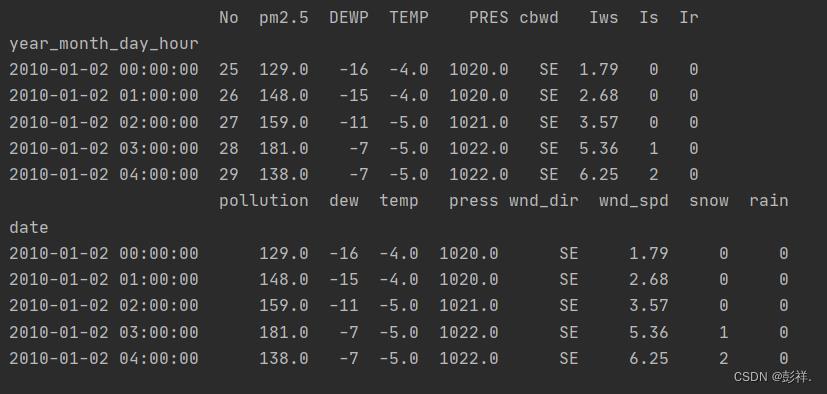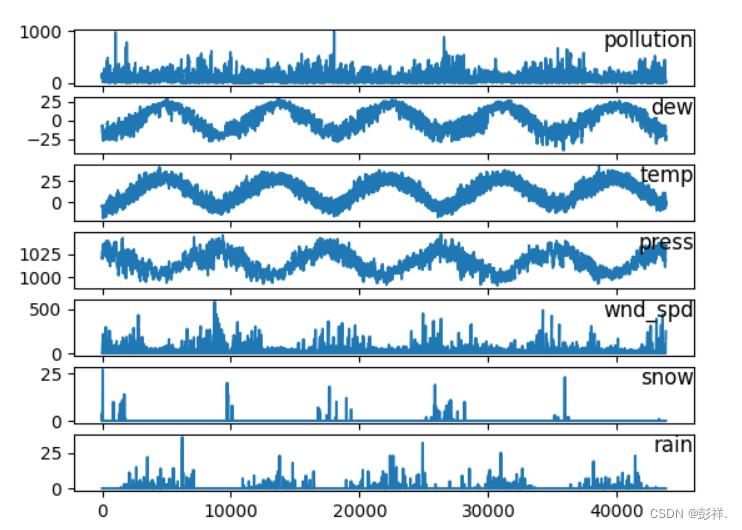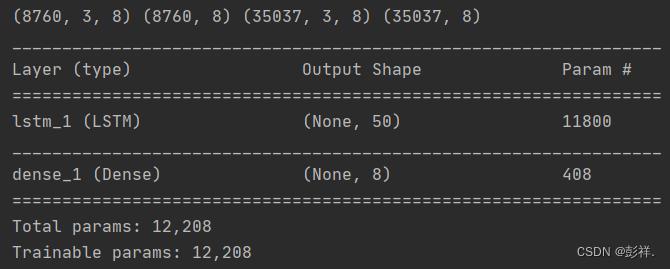LSTM实现环境质量预测的实现
Posted 彭祥.
tags:
篇首语:本文由小常识网(cha138.com)小编为大家整理,主要介绍了LSTM实现环境质量预测的实现相关的知识,希望对你有一定的参考价值。
LSTM可以实现时序数据的预测,下面以一个环境质量变化的时序序列来介绍其实现和处理过程。
LSTM模型

数据集介绍
首先是数据集:里面有9个变量值,其中包含时间和其他环境指标变量
,经过数据处理过程效果如下:

from pandas import read_csv
from datetime import datetime
# load data
def parse(x):
return datetime.strptime(x, '%Y %m %d %H')
dataset = read_csv('raw.csv', parse_dates = [['year', 'month', 'day', 'hour']], index_col=0, date_parser=parse)
print(dataset.head(5))
dataset.drop('No', axis=1, inplace=True)
# manually specify column names
dataset.columns = ['pollution', 'dew', 'temp', 'press', 'wnd_dir', 'wnd_spd', 'snow', 'rain']
dataset.index.name = 'date'
# mark all NA values with 0
dataset['pollution'].fillna(0, inplace=True)
# drop the first 24 hours
dataset = dataset[:]
# summarize first 5 rows
print(dataset.head(5))
# save to file
dataset.to_csv('pollution.csv')
主要是将原数据的日期格式进行规范,删除一些缺失值数据来生成我们需要的数据集。

图表展示
将数据进行图表输出:
from pandas import read_csv
from matplotlib import pyplot
# load dataset
dataset = read_csv('pollution.csv', header=0, index_col=0)
values = dataset.values
# specify columns to plot
groups = [0, 1, 2, 3, 5, 6, 7]
i = 1
# plot each column
pyplot.figure()
for group in groups:
pyplot.subplot(len(groups), 1, i)
pyplot.plot(values[:, group])
pyplot.title(dataset.columns[group], y=0.5, loc='right')
i += 1
pyplot.show()
接下便是模型读取数据,训练,评估的过程了:
其实现的是一个多步长,多变量的时间序列预测过程:
生成监督数据
首先对数据集进行处理为监督数据,将其转换为3–>1的预测数据格式。
# 转换成监督数据,四列数据,3->1,三组预测一组
def series_to_supervised(data, n_in=1, n_out=1, dropnan=True):
n_vars = 1 if type(data) is list else data.shape[1]
df = DataFrame(data)
cols, names = list(), list()
# input sequence (t-n, ... t-1)
# 将3组输入数据依次向下移动3,2,1行,将数据加入cols列表(技巧:(n_in, 0, -1)中的-1指倒序循环,步长为1)
for i in range(n_in, 0, -1):
cols.append(df.shift(i))
names += [('var%d(t-%d)' % (j+1, i)) for j in range(n_vars)]
# forecast sequence (t, t+1, ... t+n)
# 将一组输出数据加入cols列表(技巧:其中i=0)
for i in range(0, n_out):
cols.append(df.shift(-i))
if i == 0:
names += [('var%d(t)' % (j+1)) for j in range(n_vars)]
else:
names += [('var%d(t+%d)' % (j+1, i)) for j in range(n_vars)]
# cols列表(list)中现在有四块经过下移后的数据(即:df(-3),df(-2),df(-1),df),将四块数据按列 并排合并
agg = concat(cols, axis=1)
# 给合并后的数据添加列名
agg.columns = names
print(agg)
# 删除NaN值列
if dropnan:
agg.dropna(inplace=True)
return agg
读取数据,并进行风向编码:将单词变为数据,并进行标准化缩放
# load dataset
dataset = read_csv('pollution.csv', header=0, index_col=0)
values = dataset.values
# 对“风向”列进行整数编码
encoder = LabelEncoder()
values[:,4] = encoder.fit_transform(values[:,4])#fit_transform就是将序列重新排列后再进行标准化
print(values[:,4])
values = values.astype('float32')
# 标准化/放缩 特征值在(0,1)之间
scaler = MinMaxScaler(feature_range=(0, 1))
scaled = scaler.fit_transform(values)
转换为监督数据:
# 用3小时数据预测一小时数据,8个特征值
n_hours = 3
n_features = 8
# 构造一个3->1的监督学习型数据
reframed = series_to_supervised(scaled, n_hours, 1)
print(reframed.shape)
所得的数据格式:(43797, 32)即有43797条数据,按每个小时划分,32个变量值

划分训练集与测试集,并设置输入值与输出值,设置前一年的数据进行训练,取每组数据的前38个为输入值,后18为输出值,取剩下的数据,即三年数据为测试集。
values = reframed.values
# 用一年的数据来训练
n_train_hours = 365 * 24
train = values[:n_train_hours, :]
test = values[n_train_hours:, :]
# split into input and outputs
n_obs = n_hours * n_features
# 有32=(4*8)列数据,取前24=(3*8) 列作为X,倒数第8列=(第25列)作为Y
train_X, train_y = train[:, :n_obs], train[:, -n_features]
test_X, test_y = test[:, :n_obs], test[:, -n_features]
print(train_X.shape, len(train_X), train_y.shape)
(8760, 24) 8760 (8760,)
(8760, 3, 8) (8760,) (35037, 3, 8) (35037,)
设计网络模型
# 设计网络
model = Sequential()
model.add(LSTM(50, input_shape=(train_X.shape[1], train_X.shape[2])))
model.add(Dense(1))
model.compile(loss='mae', optimizer='adam')
拟合网络
history = model.fit(train_X, train_y, epochs=50, batch_size=8, validation_data=(test_X, test_y), verbose=2, shuffle=False)
图表展示数据误差值
# plot history
pyplot.plot(history.history['loss'], label='train')
pyplot.plot(history.history['val_loss'], label='test')
pyplot.legend()
pyplot.show()
数据预测
# 执行预测
yhat = model.predict(test_X)
# 将数据格式化成 n行 * 24列
test_X = test_X.reshape((test_X.shape[0], n_hours*n_features))
# 将预测列据和后7列数据拼接,因后续逆缩放时,数据形状要符合 n行*8列 的要求
inv_yhat = concatenate((yhat, test_X[:, -7:]), axis=1)
# 对拼接好的数据进行逆缩放
inv_yhat = scaler.inverse_transform(inv_yhat)
inv_yhat = inv_yhat[:,0]
test_y = test_y.reshape((len(test_y), 1))
# 将真实列据和后7列数据拼接,因后续逆缩放时,数据形状要符合 n行*8列 的要求
inv_y = concatenate((test_y, test_X[:, -7:]), axis=1)
# 对拼接好的数据进行逆缩放
inv_y = scaler.inverse_transform(inv_y)
inv_y = inv_y[:,0]
# 计算RMSE误差值
rmse = sqrt(mean_squared_error(inv_y, inv_yhat))
print('Test RMSE: %.3f' % rmse)
系统改进
之前博主在看这个系统时,发现了几个问题,即他最终的输出结果是pollution等级,他是如何实现的呢?
首先,在切分数据集是,他取前24列作为已知序列,使用倒数第8列为预测数列,即标签:
# 有32=(4*8)列数据,取前24=(3*8) 列作为X,倒数第8列=(第25列)作为Y
train_X, train_y = train[:, :n_obs], train[:, -n_features]#注意这里的-n_features是倒数第8列而非倒数最后8列
test_X, test_y = test[:, :n_obs], test[:, -n_features]
确定了我们的输出结果为1列,那么我们最后的全连接层设为1即可:
model = Sequential()
model.add(LSTM(50, input_shape=(train_X.shape[1], train_X.shape[2])))
model.add(Dense(1))
然后我们的数据格式如何规范呢,在我们的fit这里就做了限定:
history = model.fit(train_X, train_y, epochs=2, batch_size=8, validation_data=(test_X, test_y), verbose=2, shuffle=False)#指明了训练集测试集,这也叫声明了格式
那么到这里问题就很清晰了,如果我想让我的结果为八个属性值呢,我们只需要这样做:将标签取后8个:
# 有32=(4*8)列数据,取前24=(3*8) 列作为X,倒数后8列=(第25列)作为Y
train_X, train_y = train[:, :n_obs], train[:, -n_features:]
test_X, test_y = test[:, :n_obs], test[:, -n_features:]
print(train_X.shape, len(train_X), train_y.shape,train_y)
# 将数据转换为3D输入,timesteps=3,3条数据预测1条 [samples, timesteps, features]
train_X = train_X.reshape((train_X.shape[0], n_hours, n_features))
test_X = test_X.reshape((test_X.shape[0], n_hours, n_features))
train_Y = train_y.reshape((train_y.shape[0], 1, n_features))
test_Y = test_y.reshape((test_y.shape[0], 1, n_features))
#并进行格式转换
对网络的输出结果进行限定,全连接层改为8
model = Sequential()
model.add(LSTM(50,input_shape=(train_X.shape[1], train_X.shape[2])))
model.add(Dense(8))
其余不用改变,这样他的输出结果变为后8个变量了

以上是关于LSTM实现环境质量预测的实现的主要内容,如果未能解决你的问题,请参考以下文章